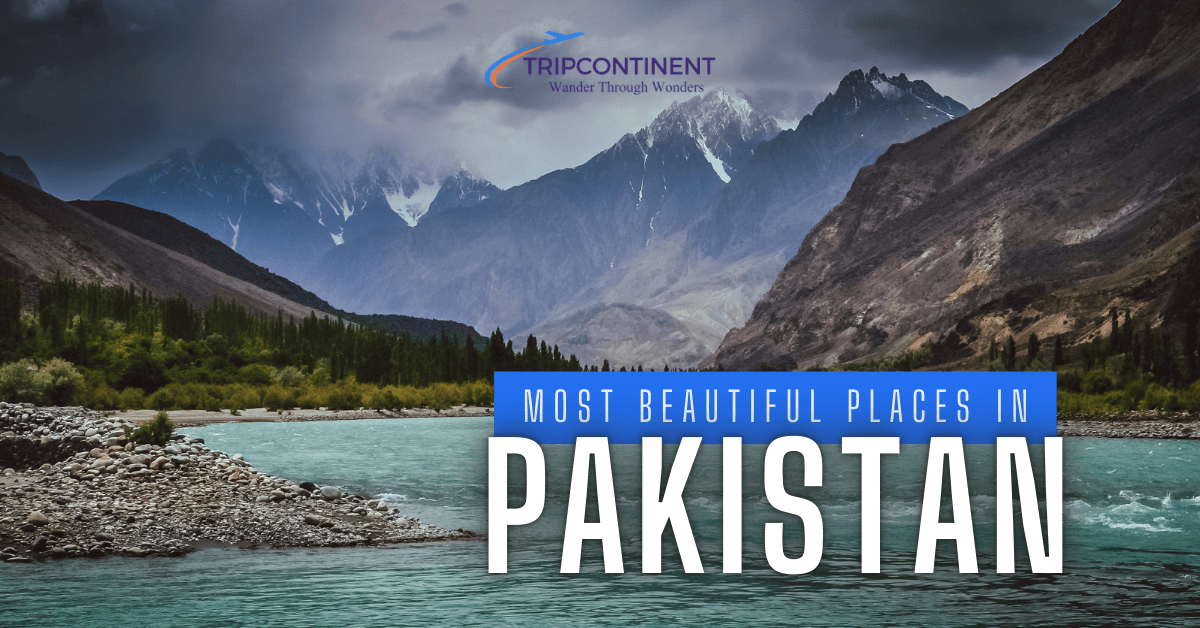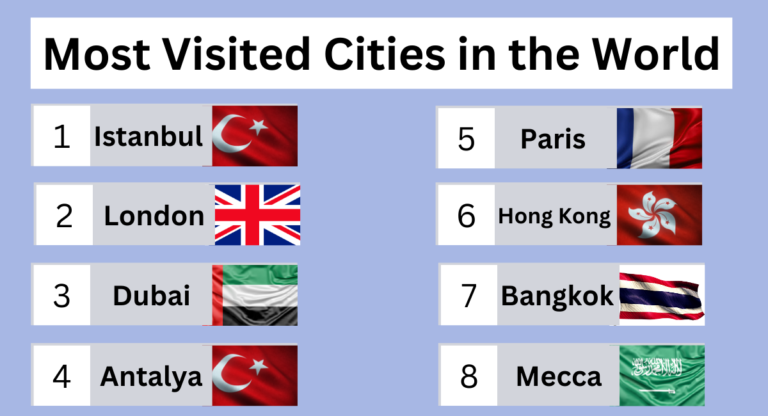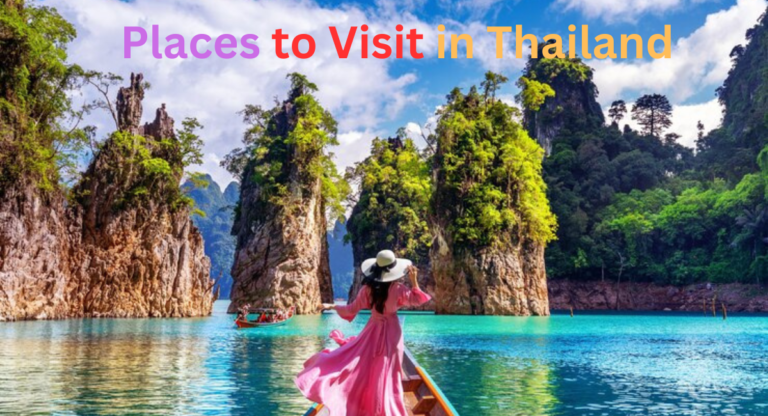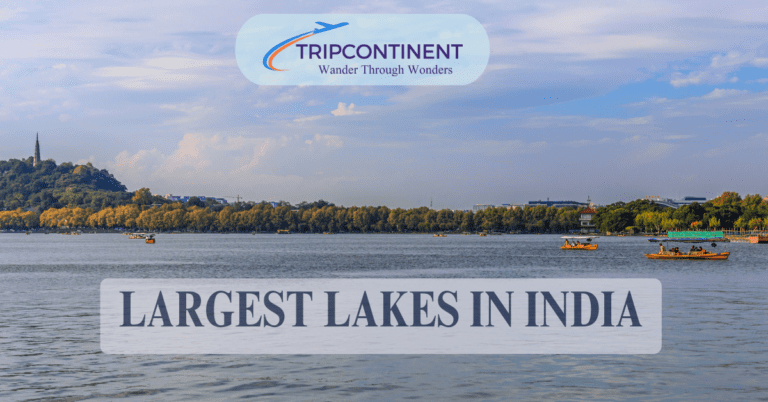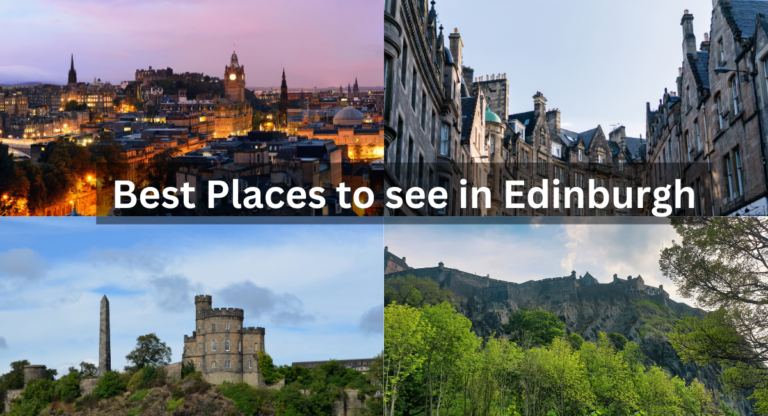12 Most Beautiful Places in Pakistan You Must Visit in 2024
Pakistan is a home to diverse landscapes, comprising peak mountains, wind-swept plains, hidden valleys, and intricately detailed mosques. With the unique blend of bustling cities, historical landmarks, and arid deserts, the country is offering the rich tapestry of ancient nations and modern civilization. Boasting natural wonders including green fields and forests, rivers, hilly areas, clear blue sky, and snow covered summits, Pakistan’s picturesque land is famous among tourists across the globe. This God-gifted land is blessed with numerous natural resources and occupies the world’s most beautiful places.
In this comprehensive guide, we’ll delve into details to explore the top sights of Pakistan.
List of the Top 12 Most Beautiful Places in Pakistan
Here is the list of top most beautiful places in Pakistan.
- Faisal Mosque
- Swat Valley
- Kalash Valley
- Neelam Valley
- Pakistan Monument
- Nanga Parbat
- Hunza Valley
- Kaghan Valley
- Clifton Beach
- Fairy Meadows
- Passu Cathedral Peaks
- Rakaposhi Base Camp
1. Faisal Mosque
Faisal Mosque stands as one of the most iconic landmarks of Islamabad and a jewel in Pakistan’s architectural crown. As the largest mosque in Pakistan and the grandest in Asia, it commands attention with its stunning blend of modern and traditional Islamic design. Spread over an impressive 5,000 square meters (91,984 square feet), the mosque’s unique silhouette dominates the city’s skyline. Its four towering minarets, inspired by modern Turkish architecture, reach towards the heavens, creating a majestic visual spectacle that captivates visitors from near and far.
The mosque’s location at the foot of the Margalla Hills adds to its allure, offering breathtaking panoramic views of the surrounding landscape. Lush greenery envelops the complex, enhancing its beauty and creating a serene atmosphere for prayer and contemplation. The stark white marble structure contrasts beautifully with the verdant backdrop, making it a photographer’s dream and a must-visit attraction for tourists and pilgrims alike.
Faisal Mosque is not just a place of worship but also a symbol of Pakistan’s cultural heritage and architectural prowess. Its unique design, blending contemporary elements with Islamic traditions, reflects the nation’s forward-looking spirit while honoring its rich religious heritage.
Best Time to Visit: 05:00 AM to 10:00 PM
Read More: Historical Places in Pakistan
2. Swat Valley
Nestled in the Khyber Pakhtunkhwa province of Pakistan, Swat Valley is a breathtaking paradise that has earned the moniker “Switzerland of the East.” This lush green valley, surrounded by snow-capped mountains, offers a mesmerizing blend of natural beauty and rich history. The crystal-clear Swat River meanders through the valley, creating a picturesque landscape that captivates visitors year-round.
Swat Valley boasts a wealth of attractions, from ancient Buddhist ruins to serene lakes and dense forests. The region’s main town, Mingora, serves as a gateway to the valley’s treasures, including the famous Swat Museum, which houses a remarkable collection of Gandhara art. Adventure enthusiasts can enjoy trekking, fishing, and skiing in the winter months at the Malam Jabba ski resort.
The valley’s mild summers and snowy winters make it an ideal destination for all seasons. Visitors can explore charming villages, experience local Pashtun culture, and indulge in delicious regional cuisine. With its stunning scenery, archaeological sites, and warm hospitality, Swat Valley offers a truly unforgettable experience for nature lovers and history buffs alike.
Best Time to Visit: April to October for general tourism and December to February for winter sports
3. Kalash Valley
Tucked away in the Hindu Kush mountains of Chitral district, the Kalash Valley is home to the ancient Kalash tribe, one of Pakistan’s smallest ethnic and religious minorities. This remote valley offers visitors a unique glimpse into a culture that has preserved its distinct traditions, language, and polytheistic beliefs for centuries.
The Kalash people, known for their colorful attire and vibrant festivals, inhabit three main valleys: Bumburet, Rumbur, and Birir. Each valley boasts its own charm, with traditional wooden houses perched on steep hillsides and surrounded by terraced fields and orchards. Visitors can explore the Kalash museums, which showcase the tribe’s rich heritage, intricate crafts, and traditional costumes.
The valley comes alive during the Kalash festivals, particularly Chilam Joshi in spring and Choimus in winter, featuring traditional dances, music, and rituals. These celebrations offer a rare opportunity to witness and participate in age-old customs. Nature enthusiasts can enjoy trekking through pristine landscapes, while cultural explorers can engage with locals to learn about their unique way of life.
Best Time to Visit: May to October, with festival times being particularly special
4. Neelam Valley
The Neelam Valley, often referred to as the “Blue Gem” of Azad Kashmir, is a 144 km long bow-shaped valley that follows the Neelum River. This picturesque region is renowned for its breathtaking landscapes, featuring lush green meadows, dense forests, and snow-capped mountains that create a mesmerizing tapestry of natural beauty.
Visitors to the Neelam Valley can explore charming towns like Athmuqam, Keran, and Sharda, each offering unique attractions and stunning views. The valley is dotted with crystalline lakes, gushing waterfalls, and serene streams, providing ample opportunities for nature lovers and adventure seekers. Trout fishing in the Neelam River is a popular activity, as is trekking through the valley’s diverse terrain.
The region’s rich cultural heritage is evident in its ancient archaeological sites, including the Sharda University ruins, which date back to the 8th century. The warm hospitality of the local people adds to the valley’s charm, offering visitors a chance to experience traditional Kashmiri culture and cuisine.
Best Time to Visit: April to October, when the weather is mild and the landscapes are at their most vibrant
5. Pakistan Monument
The Pakistan Monument, an iconic national landmark, stands proudly atop the Shakarparian Hills in Islamabad. This architectural marvel, designed to resemble a blooming flower, symbolizes the unity and resilience of the Pakistani people. The monument’s unique structure consists of four large petals representing the four provinces, with three smaller petals signifying the territories of Pakistan.
Visitors approaching the monument are greeted by a museum that offers a comprehensive journey through Pakistan’s history. The museum houses an impressive collection of artifacts, photographs, and multimedia displays that chronicle the country’s struggle for independence and its subsequent development. Giant portraits of the nation’s founding fathers, including Quaid-e-Azam Muhammad Ali Jinnah, adorn the walls, paying homage to their vision and sacrifices.
The monument’s elevated location provides panoramic views of Islamabad, offering a stunning backdrop for photographs. At night, the illuminated structure creates a mesmerizing spectacle visible from various parts of the city. The Pakistan Monument serves not only as a tourist attraction but also as an educational site, fostering a sense of national pride and unity among visitors.
Best Time to Visit: 9:00 AM to 9:00 PM, with evening visits offering spectacular views of the illuminated monument
Read Also: Cold Places in Pakistan
6. Nanga Parbat
Nanga Parbat, known as the “Killer Mountain,” is the ninth highest mountain in the world. Located in the Gilgit-Baltistan region of Pakistan, it stands at an impressive 8,126 meters (26,660 feet) tall. This massive peak is part of the western Himalayas and is famous for its challenging climbing routes and dramatic scenery.
The mountain’s name means “Naked Mountain” in Urdu, referring to its bare rock faces and lack of permanent snow at lower elevations. Nanga Parbat is surrounded by glaciers and offers breathtaking views of the surrounding landscape. The Fairy Meadows, a lush green plateau at its base, serves as a popular starting point for trekkers and climbers.
Despite its beauty, Nanga Parbat has a reputation for being one of the most dangerous mountains to climb. However, for adventurers and nature lovers, the area around the mountain offers stunning hiking trails and opportunities to experience the raw beauty of the Himalayas. Visitors can enjoy panoramic views, diverse flora and fauna, and the unique culture of the local communities.
Best Time to Visit: June to September for trekking; winter months for viewing snow-covered landscapes
Read Also: Cold Places in Pakistan
7. Hunza Valley
Hunza Valley is a picturesque region nestled in the Gilgit-Baltistan area of northern Pakistan. Known for its stunning natural beauty and the longevity of its inhabitants, Hunza is often called a “paradise on earth.” The valley is surrounded by snow-capped mountains, including the famous Rakaposhi peak, creating a dramatic and awe-inspiring landscape.
Visitors to Hunza can explore ancient forts like Baltit Fort and Altit Fort, which offer insight into the area’s rich history and spectacular views of the valley. The region is also famous for its delicious fruits, particularly apricots, and it’s warm, hospitable people. Hunza’s main town, Karimabad, is a charming place to experience local culture and shop for traditional handicrafts.
The valley is a haven for nature lovers and adventure enthusiasts, offering opportunities for trekking, rock climbing, and witnessing the changing colors of the landscape through different seasons. The Attabad Lake, with its turquoise waters, has become a popular attraction for boating and photography. Hunza’s clean air, peaceful atmosphere, and stunning scenery make it a must-visit destination in Pakistan.
Best Time to Visit: May to October, when the weather is mild and fruit trees are in bloom or bearing fruit
8. Kaghan Valley
Kaghan Valley is a scenic wonderland located in the Mansehra District of Khyber Pakhtunkhwa, Pakistan. Stretching over 155 kilometers, this valley is famous for its pristine natural beauty, featuring lush green meadows, pine forests, crystal-clear lakes, and snow-capped mountains. The Kunhar River flows through the valley, adding to its picturesque charm.
Visitors to Kaghan Valley can explore numerous attractions, including the beautiful Lake Saiful Muluk, known for its clear blue waters and local legends. The valley is dotted with charming towns and villages, such as Balakot, Naran, and Kaghan, each offering unique experiences and stunning views. Adventure enthusiasts can enjoy activities like hiking, fishing, and horseback riding.
The Babusar Pass, at the northern end of the valley, provides breathtaking panoramic views and serves as a gateway to Gilgit-Baltistan. Throughout the journey, travelers can enjoy the diverse flora and fauna, including rare species like the snow leopard and Himalayan brown bear. With its cool climate and natural wonders, Kaghan Valley offers a perfect retreat from the summer heat.
Best Time to Visit: June to September, when the weather is pleasant and all parts of the valley are accessible
Read Also: Most Beautiful Places in KPK
9. Clifton Beach
Clifton Beach is a popular seaside destination located in Karachi, Pakistan’s largest city. Stretching along the Arabian Sea, this urban beach offers a refreshing escape from the bustling city life. It’s a favorite spot for locals and tourists alike, known for its long stretch of sandy shore and vibrant atmosphere.
Visitors to Clifton Beach can enjoy a variety of activities, from camel and horse rides along the shore to savoring delicious street food from numerous vendors. The beach comes alive in the evenings when families and friends gather to watch the sunset, fly kites, or take a stroll along the water’s edge. The nearby Clifton Beach Park offers additional recreational facilities and green spaces.
One of the beach’s main attractions is the Port Grand, a recreational area featuring restaurants, shops, and entertainment options. The iconic Do Darya, a strip of seafood restaurants, is also located nearby, offering dining experiences with beautiful sea views. While swimming is not recommended due to strong currents, Clifton Beach remains a vital part of Karachi’s social and cultural life.
Best Time to Visit: October to March, when the weather is cooler and more pleasant for outdoor activities
10. Fairy Meadows
Fairy Meadows, locally known as Joot, is a stunning alpine meadow located at the base of Nanga Parbat, the world’s ninth highest mountain in Gilgit-Baltistan. This lush green plateau offers breathtaking views of Nanga Parbat’s Rakhiot face and the surrounding snow-capped peaks.
Reaching Fairy Meadows is an adventure in itself, involving a jeep ride on a narrow mountain road followed by a trek or horse ride. Once there, visitors are rewarded with a serene landscape of grassy fields dotted with wildflowers, surrounded by dense pine forests. The area offers basic accommodations in the form of wooden cabins and camping sites, allowing travelers to immerse themselves in nature.
Activities at Fairy Meadows include hiking, photography, and simply soaking in the awe-inspiring views. For more adventurous visitors, it serves as a base camp for treks to Nanga Parbat Base Camp. The night sky at Fairy Meadows is particularly spectacular, offering clear views of stars and the Milky Way. This magical place lives up to its name, providing an unforgettable experience of Pakistan’s natural beauty.
Best Time to Visit: June to September, when the weather is mild and the meadows are lush and green
11. Passu Cathedral Peaks
The Passu Cathedral Peaks, also known as Passu Cones, are a series of jagged mountain spires located in the Upper Hunza region of Gilgit-Baltistan, Pakistan. These dramatic peaks, resembling a cathedral’s spires, create one of the most iconic and photographed landscapes in the country.
Visitors can enjoy stunning views of the Passu Cathedral from the Karakoram Highway, with the best vantage points near the village of Gulmit. The peaks, rising sharply against the sky, offer a mesmerizing sight that changes with the light throughout the day. At sunset, the mountains are often bathed in golden light, creating a truly magical scene.
While climbing the Cathedral Peaks is reserved for experienced mountaineers, the surrounding area offers excellent opportunities for trekking and photography. Nearby attractions include the Passu Glacier and the Hussaini Suspension Bridge, known as one of the most dangerous bridges in the world. The local Wakhi people are known for their hospitality, and visitors can experience their unique culture and traditions.
Best Time to Visit: May to October, when the weather is suitable for travel and the views are generally clear
12. Rakaposhi Base Camp
Rakaposhi Base Camp offers adventurers and nature enthusiasts a close-up view of one of the most beautiful mountains in the Karakoram range. Rakaposhi, meaning “Shining Wall” in the local language, stands at 7,788 meters (25,551 feet) and is known for its stunning beauty and challenging climbing routes.
The trek to Rakaposhi Base Camp is moderately difficult but rewards hikers with breathtaking views of the surrounding peaks, glaciers, and alpine meadows. The journey typically starts from the village of Minapin in the Nagar Valley and takes about 2-3 days round trip. Along the way, trekkers pass through beautiful forests, cross streams, and experience the tranquility of the high mountains.
At the base camp, visitors are treated to panoramic views of Rakaposhi and other nearby peaks. The area is known for its diverse flora and fauna, including ibex and snow leopards. Camping at the base camp allows for an immersive experience in the pristine mountain environment. While technical climbing gear isn’t necessary for the base camp trek, proper preparation and acclimatization are important.
Best Time to Visit: June to September, when the weather is most favorable for trekking and the wildflowers are in bloom
Conclusion
Pakistan boasts a unique blend of nature and history, promising unforgettable experiences for all. From the famous landmark of Faisal Mosque and Pakistan Monument to the lush green spot of Swat Valley, small paradise as Hunza Valley, Magical Fairy Meadows, and enthralling destination of Rakaposhi Base Camp, each place offers a mesmerizing beauty in one way or another. The land encapsulates beauty at every corner. If you’re planning to visit Pakistan, must consider these incredibly beautiful places which will surely leave you in awe!
FAQ’s
Which Is the Most Beautiful Place in Pakistan?
Pakistan is a land of world’s most beautiful places which include Hunza valley, Swat valley, Neelum valley, Attabad lake, Badshahi Mosque, and so on.
Which Is the Most Green Place in Pakistan?
Islamabad, the capital city of Pakistan, is famous for its lush green surroundings, beautiful parks, and abundant greenery. While nestled against the backdrops of Margalla Hills, the city offers eye-captivating natural beauty.
Which Location Is Commonly Referred to as the “Mini Switzerland of Pakistan”?
Swat valley has earned the title of “Switzerland of Pakistan” for its lush greenery, alpine forests, crystal-clear rivers, and breathtaking beauty associated with Switzerland.
What Makes Pakistan a Beautiful Country?
The diverse topography that ranges from breathtaking mountains to expansive deserts make Pakistan one of the world’s most beautiful countries. Its northern regions such as Gilgit-Baltistan and Khyber Pakhtunkhwa consist of highest peaks like K2.
What Are 4 Facts About Pakistan?
- World’s 33rd largest country.
- Holds more than 225 million people.
- Home to 108 peaks above 7,000 meters.
- Consists of the Indus River, one of the longest rivers in Asia.

I’m Sophia Jones, an adventurer at heart from New York City, USA. I live for travel and exploration, always eager to discover new places, meet fascinating people, and try out diverse cuisines. Over the past few years, I’ve traveled to numerous countries, immersing myself in different cultures and creating unforgettable memories.
